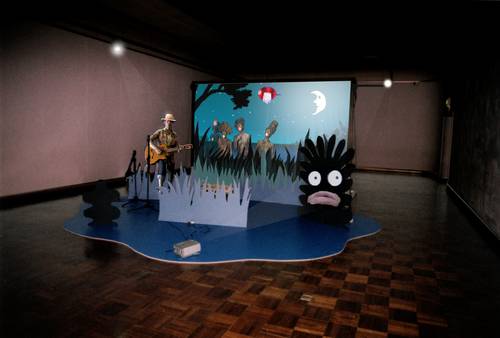A THREAD IN EGILL SÆBJØRNSSON’S LINE OF PRODUCTION FOR THE EXHIBITION "CRITICS TASTE BETTER", BERLIN 2006

What is interesting in this work is that other threads that in other works play the foreground comes together here in this work as a whole, in a complex “togetherness” that seems to me be the most interesting and striking work I have to this day seen in Sæbjørnsson’s line of production. In many of his works, the performativity in itself might play a central role, or in other cases the animations or even the theory of music in again others.
References to other artists are inevitable for this particular work though, and my mind wanders off to another gesamtkunstwerk by the artists Dan Graham, Tony Oursler and Rodney Graham – “Don’t Trust Anyone over Thirty” – a puppet theatre with a live orchestra and video projections in a combined and political work. While this example, the puppet theatre, has three originators Sæbjørnsson stands as the sole maker. The surreal environment comes together as something quite serious but with a large dose of dark humor, which also makes the work quite appealing. The work has many points of references that one could pick up on, and this is also why the work becomes complex as a whole. There is a melancholic cord that strikes one, together with the dark humor with references to old movies with slight racist prejudices of shoe-polish-painted white people trying to portray someone black; the references to hill-billy country culture and also the sticky sentimentality that originates in country music love songs that nevertheless tells us something about the human psyche. He also opens up to a critique about the self-reference since he uses himself in the role of the musician/artist. What I might object to in other works of Sæbjørnsson is that they tend to become “one-liners,” surely with lots of humor, but with a lack of the melancholia and the multi-symbolic gestures that makes it possible to interpret the work in a wide variety of ways.
As a participant in this critic/artist-show I would be curious and anxious to see yet another complex and multi-layered work by Sæbjørnsson to see the day of light. I would like to encourage Sæbjørnsson to make more of this unique blend of the surreal, the melancholic, the burlesque, the dark humour and the differentiated line of mediums come together in a new gesamtkunstwerk created by only one artist.
Power Ekroth
